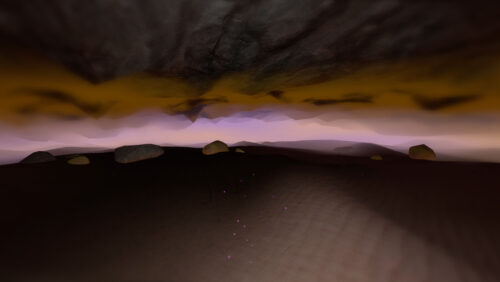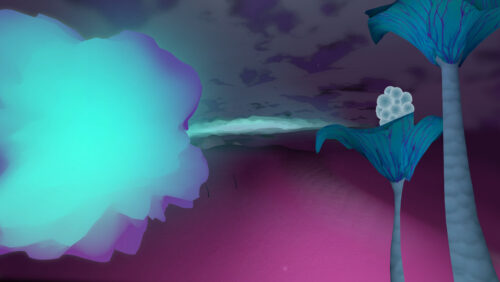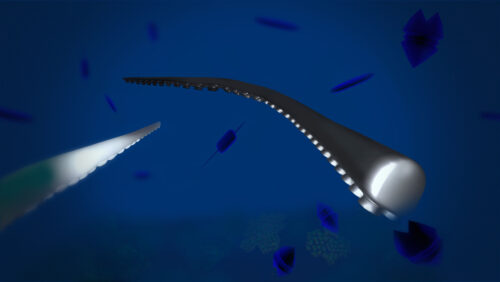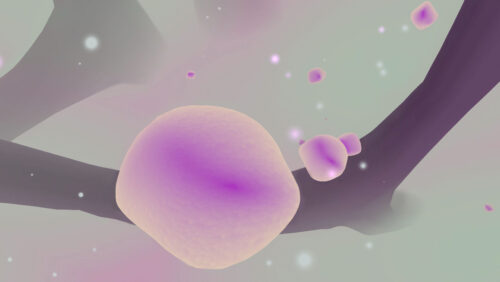Plastisapiens
Miri Chekhanovich and Édith Jorisch with Dpt.
2022
| 15 min
Virtual Reality - Quest 2
English
Awards and Festivals
Official SelectionTribeca (2022)
Official SelectionFestival du nouveau cinéma, Montreal (2022)
DocLab Special Jury Award for Creative TechnologyIDFA, Amsterdam (2022)
XR ExperiencePrix NUMIX, Montréal (Canada) 2023
BEST INNOVATION VRCinequest (USA) 2023
Prix de l'impactNewImages Festival, Paris (France) 2023
BEST EXPERIENCE/TECHNIQUEGuanajuato International Film Festival (Mexique) 2023
Produced by Dpt., the National Film Board of Canada and Lalibela Productions
With the financial participation of the Canada Media Fund, the Makor Foundation for Israeli Films, The Israel Film Council and The Israel Ministry for Culture and Sports
This project was conceived as part of New Identities, a co-production partnership in digital creation between Canada and Israel.
Take a deep breath in. Out. In. Out. Now relax and contemplate a world where plastic is completely integrated with the environment. Plastisapiens is a meditative virtual reality experience that allows us to consider this world with curiosity, playfulness and even a sense of wonder. Rooted in modern scientific research, the narrative slowly gives way to a strangely beautiful and ironic speculative work of eco-fiction, a journey through time, evolution and imagined futures. By interacting with organisms around us, then watching as our virtual, organic selves merge with plastic, the experience creates a safe space to empathize with a material that binds us all. As we are gently guided through an awe-inspiring universe of hybrid bodies, we are ultimately left to ponder how the interchanging relationship between humans and the environment transforms our identity, right down to our DNA.
Trailer
One-liner
Plastisapiens is a virtual reality journey towards a speculative future where organic beings and plastic become one.
Two-liner
What is the future of human identity? Plastisapiens takes you on a soothing and playful virtual reality journey where organic beings and plastic become one.
Long synopsis
As porous beings, we are creatures of our environment.
The more we saturate what surrounds us with plastic, the more plastic we become.
Take a deep breath in. Out. In. Out. Now relax and contemplate a world where plastic is completely integrated with the environment. Plastisapiens is a meditative VR experience that allows us to consider this world with curiosity, playfulness, even a sense of wonder.
The relationship between humans and plastic pollution is often presented as a one-way street. The year 1907 marks the first time a material was synthesized from fossil fuels, and now that material can be found everywhere from “garbage islands” in the ocean to microplastics swimming in human bloodstreams.
Rooted in scientific research, the Plastisapiens narrative slowly gives way to a strangely beautiful, speculative and ironic work of eco-fiction, a journey through time, evolution and imagined futures. As we interact with organisms around us, then watch as our virtual, organic selves merge with plastic pollution, the experience creates a safe space to empathize with a material that binds us all.
Using the Oculus Quest headset, this 15-minute journey balances gentle guidance and more than a touch of irony, care of its creators: Montreal-based filmmaker Edith Jorisch, whose documentary The Heir won two Prix Gémeaux, and Montreal-based artist Miri Chekhanovich, whose past works include fashioning bio-plastics out of agar and a video installation of a Montreal recycling centre.
Both creators cite theorist Donna Haraway and the aesthetics of Tarkovsky’s Stalker as inspiration for this project, but above all Plastisapiens was influenced by “Toxic Progeny: The Plastisphere and Other Queer Futures,” a text by author and researcher Heather Davis that explores the link between queerness, gender, reproduction, extinction and the petrochemical industry. Like that text, the “Plastosphere” created for this VR tale imagines a world beyond nihilism, a beautiful space that encourages conversation, moving from observer to participant, and reflecting on ways to transcend the binaries of today.
Jorisch and Chekhanovich met and created Plastisapiens as part of New Identities, a Canadian-Israeli co-production aimed at fostering conversations around identity and new narrative formats through digital creation. The result: their work is one of four projects made for Quest, all reimagining the boundaries of storytelling through virtual reality.
About the user experience
Plastisapiens is an interactive virtual reality experience that asks participants to explore a future where organic and plastic beings become one.
Users are invited to take a break from eco-anxiety and jarring news headlines to instead enter a calming animated space. Here, they can travel back in time to witness the origins of organic and plastic life; explore their kinship with bacteria, viruses and fungi; and watch in amazement as their (virtual) hands turn into waving tentacles, and then as those tentacles turn into new mutant appendages—a symbol of an imagined future where skin and synthetics have co-evolved, and survival of the fittest means embracing flexibility in body and mind.
Throughout the 15-minute interaction, users shift from observer to participant, and the experience is a journey from a place of reactivity and fear to a curious, even hopeful future mindset. A better place for thoughtful conversation and meaningful action around the pressing global issue of petrochemical pollutions.
Co-creator Miri Chekhanovich also serves as a narrator and gentle guide, for both the French and English versions, while Israeli composer Ori Alboher (a.k.a. ORI) provides a suitably soothing ambient soundtrack, using his voice to embody the joint relationship between plastic and organic.
The experience is also available as a multi-sensory installation, created by textile and bioplastic artists, for select events. In this version, several participants can take part at once, entering an enveloping cocoon where transparent materials help humans and the environment melt into one another. Inspired by organic forms and human biology, stalagmites can be found above and petroleum-like bioplastic “puddles” below, where life begins to grow in the form of (plastic) flowers. While seated, everybody is offered a piece of edible bioplastic—a hint at themes of porosity and hybrid bodies, and a further blurring of boundaries between participants and the space around them.
Plastisapiens was created for Quest 2 headsets and was conceived with a real-time rendering engine. It can be experienced seated or standing, with controllers or hand-tracking.
Q&A with Édith and Miri
You present a really overwhelming topic—plastic pollution—with a tone usually reserved for meditation apps. How did you choose this approach?
Miri Chekhanovich: It was important for us to face the problem rather than create a dramatic and fear-based reaction. Given that kind of meditative space, maybe it will allow genuine reflection, to actually open a conversation. To see, what can we do?
Édith Jorisch: We see and hear a lot of, like, ‘Plastic is bad!’ and ‘There’s plastic everywhere in the ocean!’ And I think, by now, pretty much everyone knows that. So we wanted to have a more positive approach of accepting that reality, and bringing hope, and ideas, and opening discussion on how we can make it better. Because we cannot go back to the past, we can only move forward with plastic. It’s a part of our reality.
Miri: We cannot change it. It’s already here. Yes, there are bacteria now, research done on mushrooms that can digest plastics, and I think it’s fascinating. But the idea is, there’s no purity, there’s no ground zero that we can come back to.
Édith: It’s now part of our evolution as humans. It’s part of our ecosystem. So what do we do with that?
What interested you about plastic in the first place?
Miri: I immigrated to Canada nine years ago, and I think the first thing I noticed was the packaging of food here. I came from Jerusalem, and I used to shop in the market, which is very ‘dirty’ by Canadian standards. Pigeons and cats just walking around, and there’s no packaging on the vegetables and fruits.
So my interest started here, and it was about waste and packaging and plastics. I created a series of workshops for children in schools, changing the idea of something that is thrown into the trash to something that is useful, turning it into an object of art. And I had another work where I was meditating in the local dump and documenting it. Later, as part of a residency called the Museum for Future Fossils, I met Heather Davis and Kelly Jazvac [of ] the Synthetic Collective, which works a lot with microplastic pollution, mostly in the Great Lakes of Ontario.
Édith: For me, I think it [came about] more [because of] the collaboration with Miri. She really fed me with a lot of scientific articles, and I became as obsessed with it as her.
How did you two end up working together?
Édith: The project started with New Identities; the NFB put out a call for six Canadian artists from different fields, and six Israeli artists. We were invited to the Haifa Film Festival in Israel, where Miri and I met. We were both working on really early stages of different ideas, and we just realized that we had really similar taste and subjects. My work talks about migration and transformation, and I have a surreal universe in some of my projects, too. So we really connected on that.
What were some of your aesthetic inspirations for the look and feel of Plastisapiens?
Édith: We both love art that has a bit of humour or irony. Anicka Yi, she’s an amazing artist.
Miri: I wrote in the credits that I really like [psychologist and author] Tara Brach. She’s an amazing person who offers these meditations, and I always feel better and more hopeful about life in general after listening to her.
Also, we were in the Venice Biennale in 2019 and both of us loved the Scandinavian pavilion. It was kind of a dystopian installation, but also really gorgeous, the materiality of it and the colour palettes. But I think overall the biggest inspiration is the text [“Toxic Progeny: The Plastisphere and Other Queer Futures”] by Heather Davis.
Plastisapiens references this academic text and delves into complex concepts like hybrid bodies and the hormones that come from plastic. How did you make these topics accessible?
Miri: It’s really a challenge, because we’re talking about transforming into creatures where biological reproduction will not necessarily exist anymore. But then, how do we mother, for example? How are we taking care of each other? And we explore this idea of making kin, a reference to Donna Haraway [cyborg manifesto theorist and author of Staying with the Trouble: Making Kin in the Chthulucene].
The idea of the narration is really about how plastic made us flexible in terms of our consciousness as well. And so, what does that mean, that we’re more flexible to accept other beings, and to accept life that is not hierarchical, and that we humans are not at the centre of the Earth?
Édith: What we really wanted to transpose is the idea that the human and the environment are becoming one, and that’s the “plastosphere” environment. There’s no gravity, there’s no end to it, there’s no time, no space. You don’t know if you’re a very, very small microbe or are in the stratosphere. Nothing is fixed.
How did virtual reality help you tell this story?
Édith: What’s funny is that we both hadn’t seen any VR when we started the project, so we discovered the medium while creating it. I do some documentaries, I’m a film director. And there, for me, there’s no purpose in doing a documentary in VR, because the technology is not there. It’s not going to feel more real, and I don’t get that same empathy feeling in documentary.
So if we’re going to use that medium that’s a bit imperfect and still feels a bit computer engineered, then let’s just create a whole universe and let’s not stick to reality too much. The thing that I don’t think I could have done in a ‘flatty’ is the transcendence. [In Plastisapiens], you look down at your hands, your skin is changing, then you have tentacles.
Miri: And that active participation. You’re going through the narrative not as an observer, but more inside. I think the power of VR is really to feel and to enter a different space.
How would you like people to feel after experiencing Plastisapiens?
Édith: Personally, I like the mixed feeling I think it creates. Because if it’s too frightening, or too moralizing, then you’re a bit like, ‘Enough!’ Like, ‘This world is so [messed up]! We have enough of people telling us what to do.’ But then if it’s too happy, I mean, we’re still talking about a serious subject. I think the way we approach it is a way to open a discussion.
Miri: I enjoy complexity and touching complexity, and not necessarily one kind of message to give. Let’s first of all look at this issue and, yeah, with a bit of irony. This kind of wink allows something else to develop, rather than just a reaction of fear.
Excerpts
Images
Loading...

Download
Loading...

Download
Loading...

Download
Loading...

Download
Loading...

Download
Loading...

Download
Team
Edith Jorisch
Writer and Director
Photo
Photo : Maxyme G. Delisle
Miri Chekhanovich
Writer and Director
Photo
Photo : Katya Konioukhova
Maude Thibodeau
Experience Director (Dpt.)
Photo
Photo : Anouk Lessard, L'Éloi
Raphaëlle Sleurs
Producer (Dpt.)
Photo
Nicolas S. Roy
Creative Director (Dpt.)
Photo
Isabelle Repelin
Producer (NFB)
Photo
Photo : Valérie Sangin
Marie-Pier Gauthier
Producer (NFB)
Photo
Photo : NFB
Louis-Richard Tremblay
Executive Producer (NFB)
Photo
Photo : NFB
Credits
Produced by
Dpt.
The National Film Board of Canada
Lalibela Productions
Original Idea
Miri Chekhanovich
Édith Jorisch
Written and Directed by
Miri Chekhanovich
Édith Jorisch
Art Direction, Concept, Script, Design and Programming
Dpt.
Music and Sound Design
Ori Alboher
Narration
Miri Chekhanovich
Voiceover Coach
Benoit Rousseau
DPT. TEAM
Creative Director
Nicolas S. Roy
Experience Director
Maude Thibodeau
Producer
Raphaëlle Sleurs
Unity Developer
Thibault Séquier
3D Artists
Pierre Chaumont
Cindy Ou
Jules Riou-Bourgeois
NFB INTERACTIVE STUDIO
Producers
Marie-Pier Gauthier
Isabelle Repelin
Executive Producer
Louis-Richard Tremblay
Senior Production Coordinator
Véronique Tessier
Technology Director
Martin Viau
Interactive Media Coordinator
Caroline Fournier
Administrator
Marie-Andrée Bonneau
Senior Administrative Coordinator
Isabelle Limoges
Production Coordinator
Isabelle Gatti
Evelyne Cortes Oquendo
Legal Services
Christian Pitchen
Project Manager, Digital Products
Catherine Perreault
Audio Recording
Luc Léger
Technical Coordinator (post-production)
Mira Mailhot
Marketing Manager
Laurianne Désormiers
With the contribution of the Interactive Studio team
Marie-Ève Babineau
Johanna Lessard
Sergiu Suciu
Lalibela Productions
Miri Chekhanovich
Danae Elon
With the financial participation of
Canada Media Fund
The National Film Board of Canada
Makor Foundation for Israeli Films
The Israel Film Council
The Ministry for Culture and Sports
On behalf of Makor Foundation for Israeli Films
Amit Goren
Eveline Kluger Kadish
This project was made possible thanks to the New Identities initiative, launched with the valuable contribution of:
The Consulate General of Israel in Montreal
Festival du nouveau cinéma
The Haifa International Film Festival
HUB Montréal
Xn Quebec
The Gesher Multicultural Film Fund
THANK YOU
For the Canada Media Fund
Nathalie Clermont
Stéphane Cosentino
Marie-France Thérien
Marilou Loncol-Daigneault
For the Makor Foundation for Israeli Films
Amit Goren
Eveline Kluger Kadish
Nir Sa’ar
For the Gesher Multicultural Film Fund
Ziv Naveh, CEO
Tal Haring
Guy Ofran
Sharon Shamir
Miriam Ben Yosef
Yael Yakirevich
Liron Benzguida Partush
Special thanks to
Danae Elon
Maude-Isabelle Delagrave
Ana Brzezinska
Kaléidoscope
René Pinnell
Tara Brach
Michal Peleg Alboher
Yehezkel Raz
Guillaume Vasseur
Raphaëlle Rousseau
Fringe festival, Adelaide (AU)
© 2022 Dpt., National Film Board of Canada, Lalibela Productions
Media Relations
-
About Dpt.
Dpt. is a digital studio crafting award-winning immersive and narrative experiences. We conceptualize, design and build content-driven work for brands and museums as well as for the entertainment, film and education industries.
-
About the NFB
The National Film Board of Canada (NFB) is one of the world’s leading digital content hubs, creating groundbreaking interactive documentaries and animation, mobile content, installations and participatory experiences. NFB interactive productions and digital platforms have won over 100 awards, including 21 Webbys. To access this unique content, visit NFB.ca.